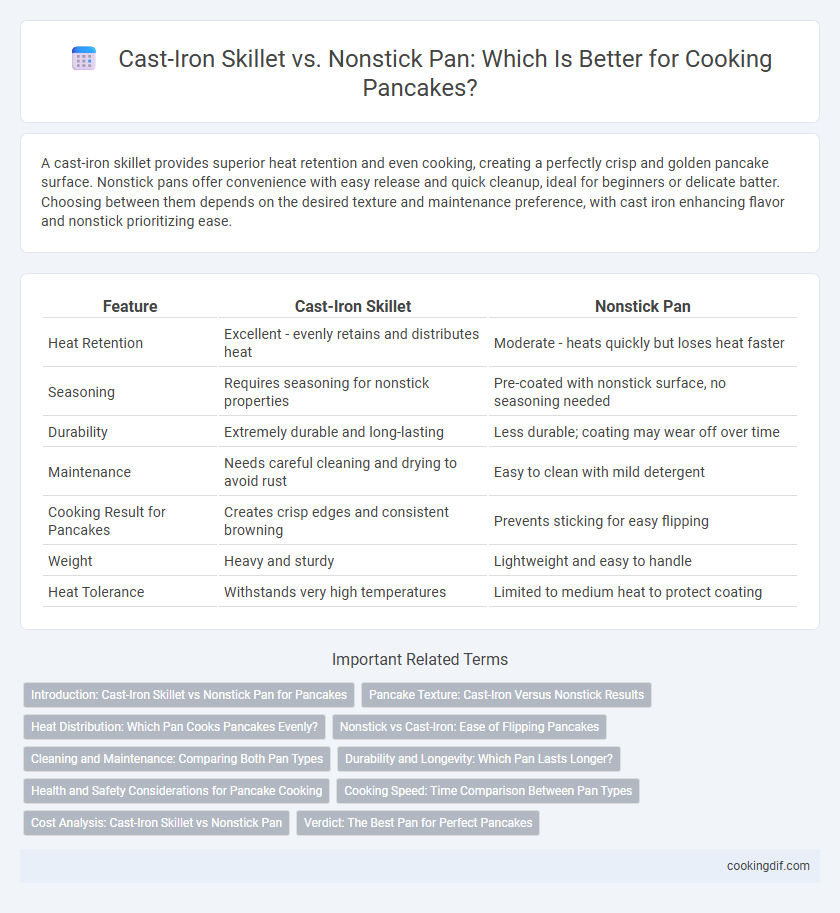A cast-iron skillet provides superior heat retention and even cooking, creating a perfectly crisp and golden pancake surface. Nonstick pans offer convenience with easy release and quick cleanup, ideal for beginners or delicate batter. Choosing between them depends on the desired texture and maintenance preference, with cast iron enhancing flavor and nonstick prioritizing ease.
Table of Comparison
| Feature | Cast-Iron Skillet | Nonstick Pan |
|---|---|---|
| Heat Retention | Excellent - evenly retains and distributes heat | Moderate - heats quickly but loses heat faster |
| Seasoning | Requires seasoning for nonstick properties | Pre-coated with nonstick surface, no seasoning needed |
| Durability | Extremely durable and long-lasting | Less durable; coating may wear off over time |
| Maintenance | Needs careful cleaning and drying to avoid rust | Easy to clean with mild detergent |
| Cooking Result for Pancakes | Creates crisp edges and consistent browning | Prevents sticking for easy flipping |
| Weight | Heavy and sturdy | Lightweight and easy to handle |
| Heat Tolerance | Withstands very high temperatures | Limited to medium heat to protect coating |
Introduction: Cast-Iron Skillet vs Nonstick Pan for Pancakes
Cast-iron skillets provide superior heat retention and even cooking, essential for achieving crispy, golden pancake edges and a perfectly cooked center. Nonstick pans offer convenience with easy release and minimal oil use, ideal for quick, low-fat pancake preparation. Choosing between cast-iron and nonstick depends on desired texture, cooking style, and maintenance preferences for optimal pancake results.
Pancake Texture: Cast-Iron Versus Nonstick Results
Cooking pancakes in a cast-iron skillet produces a superior crispy edge and evenly browned surface due to its excellent heat retention and distribution. Nonstick pans offer a softer, fluffier texture by cooking pancakes more gently and preventing sticking without the need for much oil. The choice between cast iron and nonstick directly affects pancake texture, with cast iron favoring crunchiness and nonstick emphasizing tenderness.
Heat Distribution: Which Pan Cooks Pancakes Evenly?
Cast-iron skillets excel in heat retention and distribution, allowing pancakes to cook evenly with a consistent golden-brown crust. Nonstick pans heat up quickly but often have uneven heat spots, resulting in pancakes that may cook unevenly or develop inconsistent textures. For perfectly cooked pancakes, a well-preheated cast-iron skillet ensures superior heat management and uniform cooking.
Nonstick vs Cast-Iron: Ease of Flipping Pancakes
Nonstick pans offer a smoother surface that significantly reduces the chances of pancakes sticking, making flipping effortless and preserving their perfect shape. Cast-iron skillets, while excellent for even heat distribution, require proper seasoning to achieve a nonstick effect and can be heavier to handle when flipping delicate pancakes. Choosing between the two depends on whether ease of flipping or heat retention takes priority for your pancake cooking preferences.
Cleaning and Maintenance: Comparing Both Pan Types
Cast-iron skillets require seasoning and careful cleaning to maintain their non-stick surface and prevent rust, often needing hand washing without soap and thorough drying. Nonstick pans offer easier cleaning with simple soap and water, though their coatings can degrade over time and may require replacement. Proper maintenance of cast-iron extends its lifespan indefinitely, while nonstick pans prioritize convenience but have a shorter effective lifespan.
Durability and Longevity: Which Pan Lasts Longer?
Cast-iron skillets offer superior durability and longevity, often lasting generations with proper seasoning and care, while nonstick pans typically have a shorter lifespan due to coating wear and metal utensil damage. Cast iron withstands high heat and frequent use without warping, making it ideal for long-term use in pancake cooking. Nonstick pans may provide easier release but often require replacement every few years as the coating degrades.
Health and Safety Considerations for Pancake Cooking
Cooking pancakes in a cast-iron skillet offers health benefits due to its ability to release trace amounts of iron, which can contribute to dietary iron intake. Nonstick pans require careful use to avoid overheating, as damaged coatings may release toxic fumes that pose respiratory risks. Choosing well-maintained cookware and cooking at moderate temperatures enhances safety and ensures healthier pancakes.
Cooking Speed: Time Comparison Between Pan Types
Cast-iron skillets retain heat longer and provide even cooking, which can slightly extend pancake cooking time compared to nonstick pans. Nonstick pans heat up quickly and require less preheating, allowing pancakes to cook faster overall. For efficient pancake preparation, nonstick pans offer a time advantage, especially when making multiple batches.
Cost Analysis: Cast-Iron Skillet vs Nonstick Pan
Cast-iron skillets typically range from $20 to $50, offering long-term durability and excellent heat retention, making them cost-effective over the years as they rarely need replacement. Nonstick pans generally cost between $15 and $40 but may require replacement every 1 to 3 years due to coating degradation and potential health concerns from scratched surfaces. Considering maintenance, cast-iron requires seasoning but eliminates the need for expensive utensils, whereas nonstick pans often demand gentle care and special cleaning tools to preserve their surface integrity.
Verdict: The Best Pan for Perfect Pancakes
Cast-iron skillets provide superior heat retention and even cooking, essential for achieving crispy edges and a golden-brown surface on pancakes. Nonstick pans offer convenience with easy release and faster clean-up but may lack the consistent heat distribution needed for uniform texture. For perfect pancakes, a well-seasoned cast-iron skillet is the best choice, combining durability with exceptional cooking performance.
Cast-iron skillet vs nonstick pan for cooking Infographic

 cookingdif.com
cookingdif.com